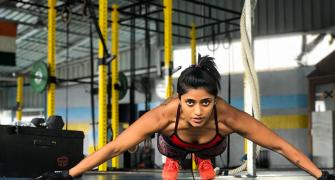Yoga instructor and meditation expert Paloma Gangopadhyay shows you how to get started with yoga at home.
Looking at the world outside, the best way is to look inwards.
Health is priceless and it is through yoga asanas, regular practising of meditation and breathing exercise that you can keep your health and your mind fit and happy.
Yoga is your physical meditation -- the pathway to achieve a brilliant body and a balanced mind.
Presenting 8 incredible, effective yet easy postures which you can try at home:
Before you begin this journey, place yourself on a yoga mat, keep a bottle of water beside you and a towel.
1. Anulom Vilom

How to do it
- Sit in a cross-legged or meditating position, preferably on the ground. Make sure that your spine and head are straight.
- Shut your eyes and relax for a few minutes. This will help in unwinding from the surroundings and relieving stress.
- Sit in this position for a few minutes with your eyes closed until you are relaxed and ready for the pranayama.
- Take your right hand and slowly place it on the right nostril, while resting your left hand on the left knee.
- Press hard so that airflow through this nostril is temporarily obstructed.
- Slowly take a deep breath from your left nostril.
- Shut both the nostrils and hold the inhaled breath for a few seconds.
- Release your finger from the right nostril, which will allow you to exhale the air from it.
- While doing so, make sure that your left nostril is safely shut with the help of your ring and little finger.
- Be slow in the process of exhaling air from your right nostril, attempting to take a longer time than inhalation.
- Next, deeply inhale from your right nostril, while shutting the other one with the ring and little finger.
- Similarly, hold your breath for a few seconds by keeping both the nostrils shut.
- Lastly, exhale from the left nostril, while shutting the right one with the thumb.
* Note: As a beginner it is not essential to have a very long exhalation as compared for inhalation. You can opt for an equal ratio of the two and can gradually increase to a ratio of 1:2 for inhalation and exhalation time.
Benefits
This pranayama when performed correctly for 5 to 6 minutes each day has numerous health benefits, other than aiding in mental peace.
Both our nostrils rhythmically take in air and function for fixed durations within the day in cycles.
While this alternating rhythm is cyclic over 24 hours in healthy individuals, it may be disturbed in the unhealthy.
The practice of anulom vilom helps to restore, equalize and balance this rhythm, and also the flow of prana in the body.
- For the brain: Practice of anulom vilom has a calming and relieving effect on the brain, and thus helps in preventing depression. It helps to improve cognitive functioning and may help in preventing age-related memory loss.
- For the skin: Reduces the incidence of acne and dermatitis.
- For the eyes: Helps to improve vision and eyesight by enhancing the blood flow to the eyes preventing vision loss.
- For the heart: Helps to lower blood pressure and thus has cardioprotective actions, reducing your risk of cardiovascular disorders.
- For the lungs: Since anulom vilom enhances an individual’s control over breathing, its practice is helpful in the management of asthmatic episodes. It also enhances ventilation of the body and also helps in reducing dyspnoea and wheezing.
- For weight loss: Studies have found that the practice of anulom vilom assists in weight loss and improvement of flexibility.
- For women: The practice of anulom vilom during pregnancy helps in reducing the risk of maternal depression, which has a tendency to extend postpartum if not treated. In non-pregnant women, this technique helps to relieve premenstrual symptoms.
2. Tadasana
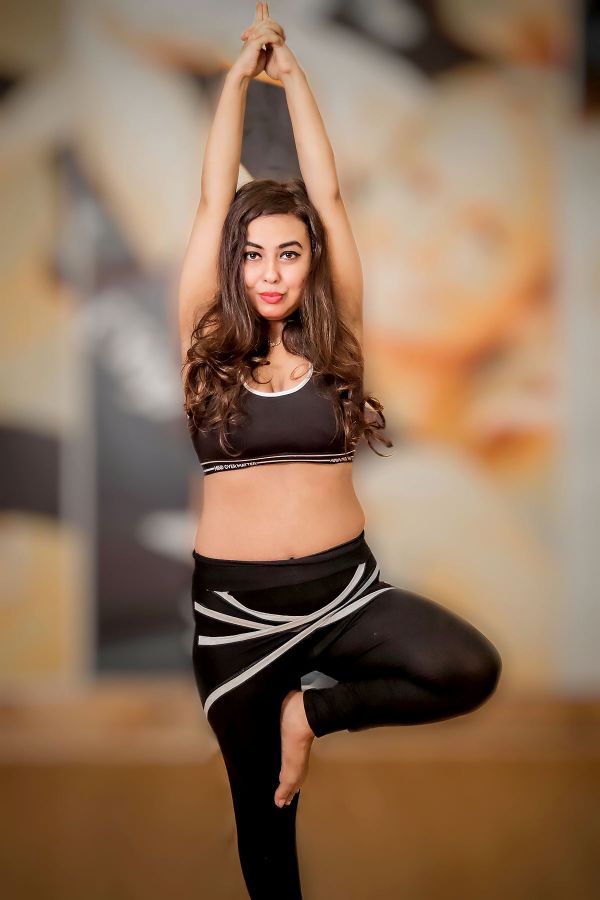
How to do it
- Stand on the ground barefoot with your legs and feet joined together. Bend your knees slightly and the straighten them to help loosen your joints.
- Firm your thigh muscles and turn them slightly inwards while lifting your knee cap. Keep in mind not to harden your lower belly. Strengthen the inner arches of your ankles while lifting them.
- Lengthen your tailbone and imagine a line of energy passing through your body.
- Going up, lift your chest up and out and push your shoulder blades back. Widen your collarbones.
- Raise your head, lengthening your neck in the process. Keep breathing deeply. While inhaling, you will feel the breath travelling through your toes, stomach and up to the head. As you exhale, feel your breath going down from the head to the stomach and finally your feet.
- Breathe in and raise your toes gently and try to balance your body on your heels. Stretch your shoulders, arms and chest upwards while your toes bear your body weight. Feel the stretch in your body from the head to the feet. Hold this pose for about 5 to 10 seconds and then gently exhale. This is a variation to the tadasana known as the Palm Tree Pose.
Benefits
- Helps in correcting your posture and improves your balance by making your spine more agile.
- Helps in increasing the flexibility of your ankles, thighs and joints.
- Can tone your hips and abdomen and helps to gain control over your muscular movements.
- May help in increasing your height if practised regularly during formative years.
- Strengthens your nervous system and regulates your respiratory and digestive functions.
3. Ardhachandrasana
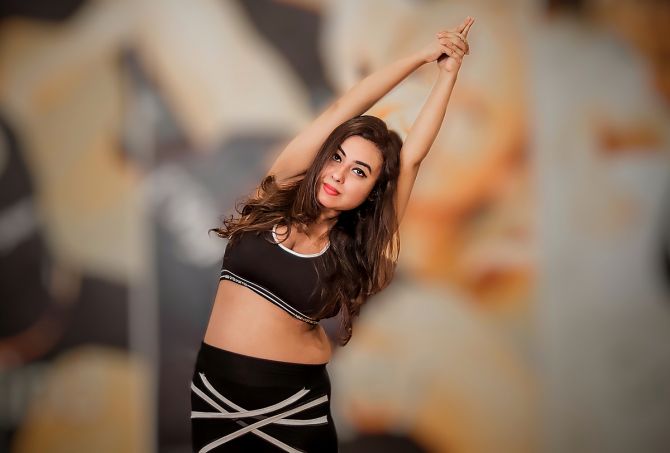
How to do it
- Begin this yoga posture by standing straight in the tadasana or the mountain pose. Place your feet apart from each other while keeping them in a parallel position to the outer edges.
- Inhale deeply and extend both of your arms in the outward direction parallel to the floor. Now turn your left foot inwards and your right foot in the outward direction in a right angle. See to it that your right foot and knee are in a straight direction and the front side of your heel is straight in line with the centre of your back.
- Gently place your left hand on your left buttock. Exhale deeply and bend your right knee while reaching for your right hand fingertips almost nine to ten inches in the front direction of your toe.
- Inhale and press your right foot on the floor while straightening your right leg. Now lift the right leg while balancing your right foot.
- Spread the left toes and externally rotate your left buttock and rib-cage in the direction of the sky.
- Your right fingertips should be placed under your shoulder while you extend your left arm above your left shoulder.
- While inhaling, press the leg which is standing.
- To come back to rest, lower your left foot on the mat behind your right foot coming into the Triangle pose. Inhale deeply and press down your feet while you rise to stand. Place your hands on your hips, straighten your right leg and turn the leg inwards while keeping the feet parallel. Turn your left leg outwards now and repeat the same steps again.
Benefits
- Helps in improving balance of the body and increases awareness. The person becomes aware of their body.
- Strengthens the hamstrings, thighs and the ankles.
- Keeps the thighbones strong while helping to get rid of back pain.
- Strengthens buttocks, spine and the abdominal muscles.
- Helps improve the process of digestion to a great extent.
- Regular practice helps improve balance and coordination.
4. Padahasthasana
How to do it
- First, stand straight and keep your body in one single line.
- Make sure that your legs are together and your hands remain just by the sides of your thighs.
- Keep your chest perfectly opened. Under any circumstances, do not tighten or stiffen your body. Stand straight and firm on your legs.
- Inhale slowly and raise your hands straight and upwards over to the head. You must touch your biceps with the ears while keeping elbows straight.
- Stretch the hands upwards as far as you can.
- Do not bend the neck forward while stretching.
- Gently turn both your palms forward.
- Start to bend your body forward with the lower back as you slowly exhale.
- Keep legs straight and make sure that you don’t bend the knees.
- Keep your hands and whole back in a single line as you make a 90° angle with your upper body and your legs.
- Keep bending forward and touch your abdomen with the thighs. Next, touch your chest with your legs.
- Keep both of your hands, palms facing down, beside each foot respectively and then touch your forehead gently to the knees.
- Make sure that you keep the breath out as far as possible; you can also go ahead with a normal breathing technique during the final position.
- Stay in this position for at least 15 to 30 seconds.
- First you lift up the forehead and then the hands from your heels.
- While inhaling slowly, gradually start lifting your body up and then stand straight.
- Keep the hands perfectly stretched upwards with the biceps closely touching your ears.
- Start exhaling slowly and bring your hands back down while you keep the palm gently on the thighs. Relax for some time as you complete the asana.
Benefits
- Helps to improve balance, flexibility, and posture of the body.
- Helps to eliminate stress, fatigue, and anxiety by simply energizing the body.
- Extremely beneficial for people suffering from problems associated with throat and nasal regions.
- Improves blood circulation particularly in the upper sections of the body.
- Helps to increase concentration as well as enhances digestion and metabolism.
- It tones and energizes the spinal nerves and muscles.
- The digestive organs can be toned by regularly practicing this asana which ensures well functioning of liver and spleen.
- Highly beneficial for people who are suffering from abdominal bloating, gastric problems, constipation, and indigestion.
- Extremely effective for removing abdominal fat.
- Is a good practice for increasing height.
- Gives a great stretch to thigh muscles.
- Helps to increase the strength of the calf muscles and thigh muscles.
5. Trikanasana
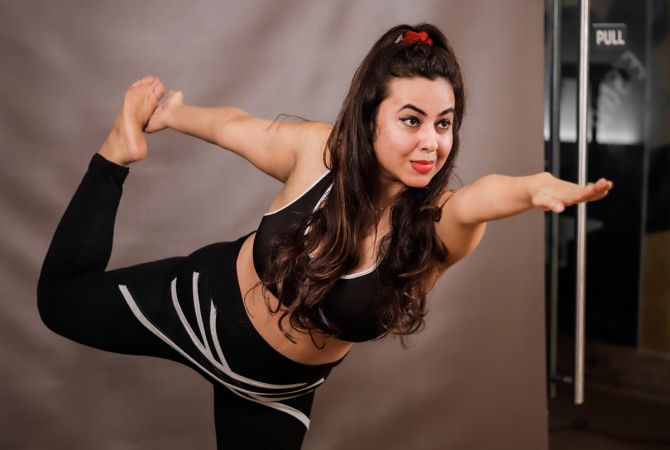
How to do it
- Stand straight. Separate your feet comfortably wide apart (about 31/2 to 4 feet).
- Turn your right foot out 90 degrees and left foot in by 15 degrees.
- Now align the centre of your right heel with the centre of your arch of left foot.
- Ensure that your feet are pressing the ground and the weight of your body is equally balanced on both the feet.
- Inhale deeply and as you exhale, bend your body to the right, downward from the hips, keeping the waist straight, allowing your left hand to come up in the air while your right hand comes down towards floor. Keep both arms in straight line.
- Rest your right hand on your shin, ankle, or the floor outside your right foot, whatever is possible without distorting the sides of the waist. Stretch your left arm toward the ceiling, in line with the tops of your shoulders. Keep your head in a neutral position or turn it to the left, eyes gazing softly at the left palm.
- Ascertain that your body is bent sideways and not backward or forward. Pelvis and chest are wide open.
- Stretch maximum and be steady. Keep taking in long deep breaths. With each exhalation, relax the body more and more. Just be with the body and the breath.
- As you inhale, come up, bring your arms down to your sides, and straighten your feet.
- Repeat the same on the other side.
Benefits
- Strengthens the legs, knees, ankles, arms and chest
- Stretches and opens the hips, groins, hamstrings, calves, shoulders, chest and spine
- Increases mental and physical equilibrium
- Helps improve digestion
- Reduces anxiety, stress, back pain and sciatica.
6. Adho mukha svanasana
How to do it
- Come onto your fours. Form a table such that your back forms the table top and your hands and feet form the legs of the table.
- As you breathe out lift the hips up, straightening the knees and elbows, form an inverted V-shape with the body.
- Hands and shoulder width apart, feet are hip width apart and parallel to each other. Toes point straight ahead.
- Press your hands into the ground. Widen through the shoulder blades. Keep the neck lengthened by touching the ears to the inner arms.
- Hold the downward dog pose and take long deep breaths. Look towards the navel.
- Exhale. Bend the knees, return to table pose. Relax.
Benefits
- This pose leaves you energised and rejuvenates the body.
- Lengthens the spine, strengthens the muscles of the chest increasing lung capacity.
- Brings strength throughout the body especially the arms, shoulders, legs and feet.
- Helps to tone muscles
- It increases circulation to the brain
- Calms the mind and helps relive headache, insomnia and fatigue.
7. Bhujangasana
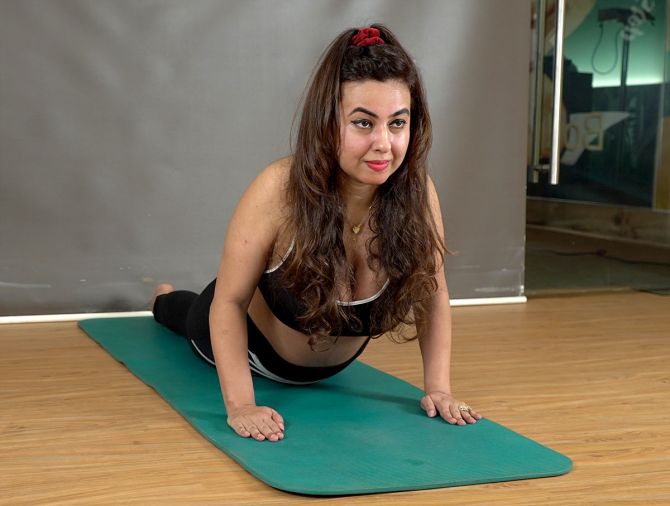
How to do it
- To start the pose, lie on your stomach and place your forehead on the floor.
- You can have your feet together, or hip width apart.
- Keep the tops of your feet pressing against the floor.
- Place your hands underneath your shoulders, keeping your elbows close to your body.
- Draw your shoulder blades back and down, and try to maintain this throughout the pose.
- Draw your pubic bone towards the floor to stabilize your lower back, and press your feet actively onto the floor.
- With the next inhale, start lifting your head and chest off the floor. Be mindful of opening the chest, and don't place all of your weight onto your hands. Keep the elbows lightly bent and keep the back muscles working. Take your hands off from the floor for a moment to see what is a comfortable, maintainable height for you.
- Keep your shoulders relaxed.
- With exhale lower yourself back onto the ground.
- Take 2-3 rounds of inhaling yourself up into the cobra, and exhaling down to the floor. Hold for 2-3 full breaths, and come back down.
- Rest on the floor for a few breaths, or enjoy child's pose as a gentle counter pose.
Benefits
- If you are suffering from rounded shoulders or stiff upper back and neck, Cobra pose can help relieve your upper body stiffness.
- The pose strengthens the entire shoulder area and upper back. It also creates more flexibility into the lower back, massages the digestive organs and relieves menstrual pain.
- This pose not only opens the physical body, but also provides a gentle opening for the heart as well.
- We open up our chest, become a bit more vulnerable, and practice being open in the world.
8. Ustrasana
How to do it
- Begin the asana by kneeling on your mat and placing your hands on your hips.
- Ensure that your knees and shoulders are in the same line, and the soles of your feet are facing the ceiling.
- Inhale, and draw your tailbone in towards your pubis. You must feel the pull at the navel.
- While you are doing that, arch your back. Gently slide your palms over your feet and straighten your arms.
- Keep your neck in a neutral position. It should not be strained.
- Hold the position for about 30 to 60 seconds before you release the pose.
Benefits
- Helps improve digestion as it massages the internal organs.
- Opens up the chest and frontal portions of the torso.
- Strengthens the back and the shoulders.
- Helps alleviate pain in the lower back.
- Makes the spine more flexible and also helps in the betterment of your posture.
- Relieves menstrual discomfort.
- End with meditation.




